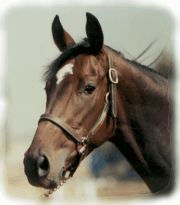|
|
A Horse,
of Course
with Don Blazer
|
 |
If you don't keep
your horse as busy as a little beaver, he might become a
wood chuck.
How much wood would a wood chuck chuck, if your wood chuck was actually
chucking wood instead of eating it?
Who knows? I don't. But I do know that Dobbin's impersonation is
detrimental to the appearance of wood fences and stall doors. And wood
chewing--if you are a horse--is a costly vice which can be quite dangerous.
Splinters in the horse's stomach and intestines can cause colic. Internal
infections and bleeding, and deaths linked to wood chewing are not unusual.
Wood chewing is generally a habit the horse develops out of nervousness
or
boredom. But it can also be a symptom of another serious problem. It can
mean the horse lacks certain nutrients in his diet or his feed does not
satisfy his natural desire for roughage. The most common missing nutrient
is salt. Be sure your horse has free access to a salt block or is fed
about a handful of table salt each day.
If the feeding program is nutritionally satisfactory, then what
contributes to making our life easier may be a contributor to the wood
chewing activity.
Examples which can be related to wood chewing include feeding pellets
exclusively, using small box stalls, and not providing the horse sufficient
exercise.
From the owner's viewpoint, pellets are a convenient form of feed. But
studies by Dr. G.F.W. Haenlein indicate that horses fed pellets exclusively
develop a strong urge to chew after their appetites have been satisfied.
There is nothing wrong with the pellets, it is the lack of roughage in
its
natural form which creates the desire to chew.
The only experiment I ever conducted proved to me that Dr. Haenlein's
more extensive research was absolutely correct. Horses which chewed wood
when pellets were fed exclusively would stop wood chewing when pellets
were
fed in combination with grass or hay. And when a horse has grass or hay
to
chew, he usually spends more time eating, therefore, he has less time
to
chew wood.
Keeping horses in box stalls certainly makes their care a lot easier.
And
for some, the 12X12-foot pen is the only solution for a lack of space.
But any small enclosure doesn't make sense to the horse.
Being confined in a small place can have negative psychological effects.
Horses want to see all the activity going on. They don't like it when
they
can hear activity, but can't see it. Being confined, a horse cannot run
and play at will, and he cannot graze over great distances. So wood
chewing becomes a way in which the stalled horse demonstrates his
displeasure with his cozy cottage.
If a stalled horse has no wood to chew, he may find a substitute--the
sucking of air, which soon makes him a cribber.
Get the horse out of the stall daily. Ride him, give him time in a turn
out pen, or get him on a walking machine. Solitary confinement is not
good
for horses.
Nervousness caused by a lack of exercise often results in wood chewing.
The horse simply has excess energy. Eventually he finds that wood chewing
relieves some of the tension just as many humans get rid of their nervous
frustration by biting their fingernails.
The right amount of exercise can usually be equated to having the horse
performing a task at which he improves. What does that mean? It means
if
you take a horse from his stall and start riding him, he will improve
his
gait or gaits as he begins to experience sufficient exercise. For example,
if you are trotting, the horse lacking sufficient exercise may want to
rush, jump or playup. As the exercise continues--with breaks to walk,
canter and rest--the horse will smooth out his trot, become receptive
to
shortening or lengthening his stride and become lighter in hand and more
supple.
About the same time you observe this improvement in the horse's
performance, you can be pretty sure he has had at least a minimum amount
of
exercise.
The correct amount of exercise cannot be measured by your watch. Ten
minutes of wild running on a lunge line is dangerous. Sufficient and
correct exercise on the lunge line will produce an improvement in the
horse's performance, not sweat and heavy breathing.
Reducing tension, eliminating boredom and/or supplying the proper roughage
and nutrients are the only satisfactory solutions to the wood chewing
problem.
|

